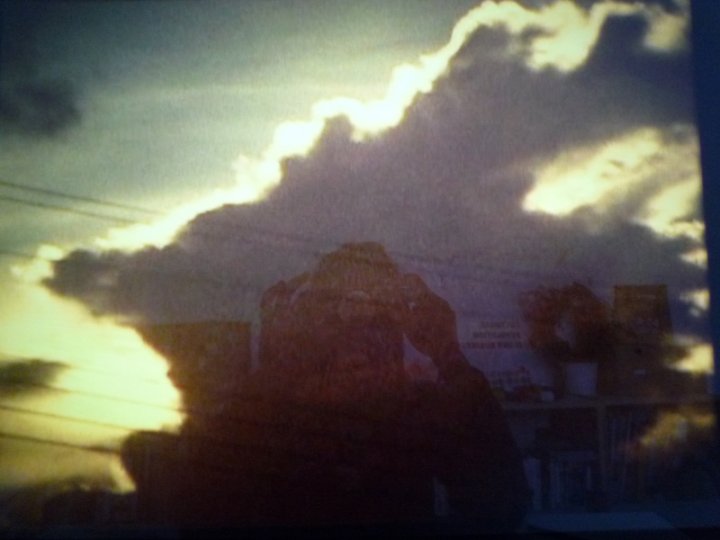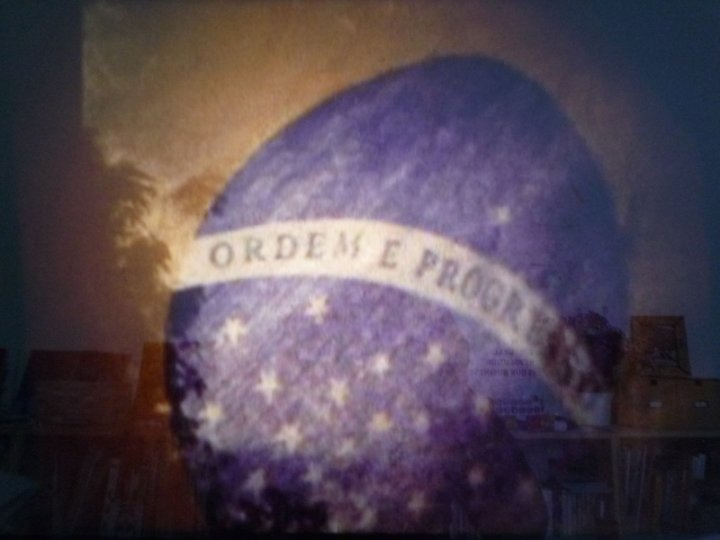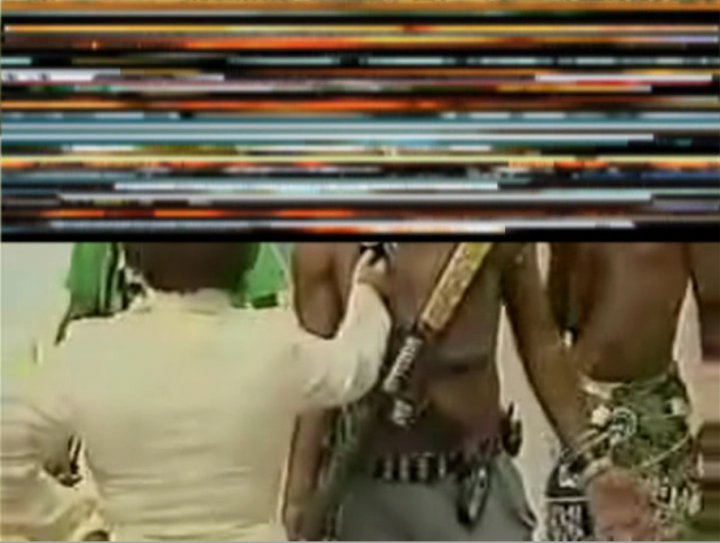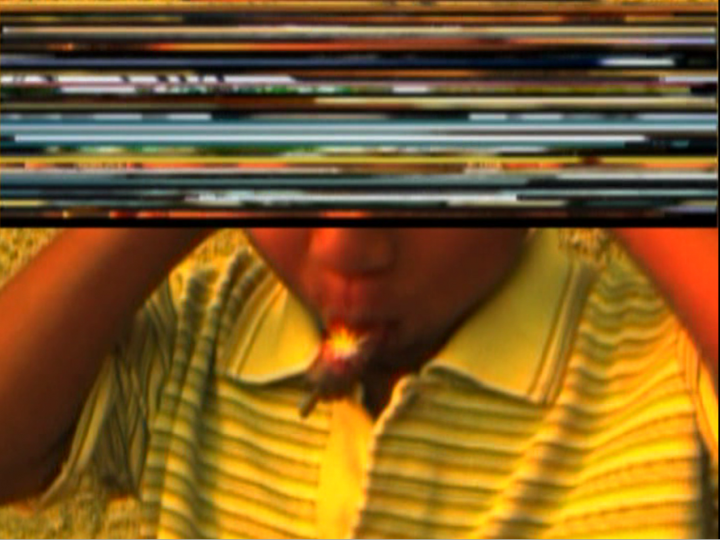
Border, Risk, and Friend
by I-Wei Li
Sunday 17 July 2011, by
Border, Risk, and Friend is an analysis about 3 of Lucas bambozzi’s video works:
- I Have No Words, experimental video, 22’, 1999
- Do Outro Lado Do Rio, documentary, 88’, 2004
- The Day Sao Paulo Stopped, short film, 8’, 2009
The review will be included in Bambozzi’s retrospective exhibition catalogue. Bambozzi’s exhibition, o espaço entre nós e os outros, took place at LLA, Mexico in 2010.
“On the border, you don’t have friends. Nobody has a friend on this side or the other side.” Joao Gomes, resident of Guyana
- I Have No Words, experimental video, 22’, 1999
- Do Outro Lado Do Rio, documentary, 88’, 2004
- The Day Sao Paulo Stopped, short film, 8’, 2009
These three films are obviously from the same author: the non-linear narratives are constructed in the same style - mixing archive footage and personal images to fuse the space and temporality. What evolves is the artist’s point of view, how Lucas Bambozzi reflects the spirit of social reality in the given specific time in which each film was made.
In I Have No Words (1999), his focus is the internal search of oneself. In Do Outro Lado Do Rio (2004), his perspective shifts to the world around him, the world in which he travels and the world which he tries to enter through conversation. With The Day Sao Paulo Stopped, (2009), he chooses to be an almost complete outsider and stranger to the subject in order to understand the catastrophic situation.
One might speculate that the shift in Bambozzi’s viewpoint is related to his life experience as an attainment of personal maturity and social stability. To enter Bambozzi’s rich body of audio-visual works since 1992, I would like to suggest three keywords: Border, Risk, and Friend to understand how the artist’s vision has evolved though the making of these three films.
I Have No Words, experimental video, 22’, 1999
I Have No Words (1999) is a youthful work, carried out with modest technical means as a formal audio-visual essay influenced by post-punk culture. In terms of content, this work reflects the inner turmoil of a generation not knowing in which direction to look or how to find structural benchmarks. The ideological bankruptcy of the authorities is obvious; it is the beginning of awareness, an awakening of the effects of globalization. Although global art movements seek to develop a ‘new’ artistic direction, in fact, artists find themselves at crossroads, not knowing clearly how to choose between the desire for recognition in the conventional contemporary art hierarchy or the fascination and attraction of mass media system.
I Have No Words depicts a generation, young and disgusted with itself, without any coherent perspective on the world. The confusion and anguish is repeated numerous times though bold, black and white text: “Concrete Silence - a lump in the throat”, “No Way Out”. We are plunged into a waking nightmare, as after a bad night spent with the wrong people, after eating bland foods, after drinking adulterated excessive alcohol, having kissed the wrong people while lost in a dismal state of intoxication. Illusive and seductive, this poetic and black despair seems to say: we are on the wrong side of the border, toward the ugliness of isolation, we risk losing ourselves, our friends are like us: lonely junkies and speechless monsters.
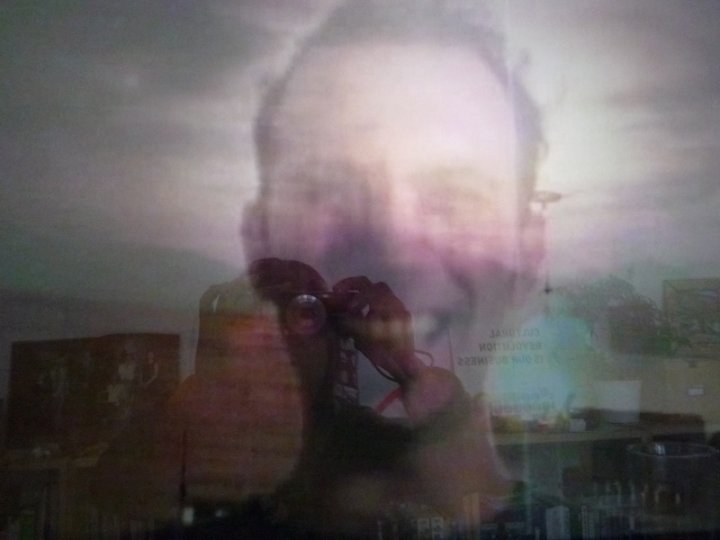
Do Outro Lado Do Rio, Documentary, 88’, 2004
Bambozzi described his experience of making the 2004 documentary, Do Outro Lado Do Rio, in Oiapoque, as being ‘hijacked’ by the fugitive characters living in the Amazon region where “reality is denied and people project themselves obsessively in what they could become beyond the boundary.” The artist leads us to the heart of the hinterland, a nowhere inhabited by dreamers, bandits and prostitutes. He became personally committed to these relationships and he was no longer in the state of despair as indicated in I Have No Words (1999). He took the risk of contacting the most dangerous men (the mafia and murderer) and of entering a territory where a man’s life is less valuable than the life of a dog. In this non-world, surrounded by hookers and gangsters, he sheds light on the fraternity and the beauty of these people – especially women – eternally in search of a more promising future.
A single short sequence summarizes beautifully the movie Do Outro Lado Do Rio, and opens the door to understanding the artist: in the middle of the film, while the characters, (young women prostitutes) speak about their hopes of leaving the city to start a new life in France, a stormy sky suddenly appears with dark clouds shaped like the map of France and Europe.
Nothing could better sum up the condition of these people, trying to avert their despair and invent a future built on mere illusions: the illusion of an otherworldly happiness, the illusion of a magic escape to France or elsewhere in Europe, and the illusion of breaking free from one’s destiny. Nor can anything better summarize the work of Bambozzi in this film, that passes without transition from documentary to a politicized allegory, told in raw poetry.
This sequence, strangely beautiful, shatters the boundaries between reality and fiction, between prose and poetry.
According to Bambozzi, Do Outro Lado Do Rio is not just about the other side of the river, it is also the other world, the one from which we have long been separated.
‘The other side’ is always the side of our wildest dreams, it is the promise of wealth if one is poor, the promise of friendship if one is alone, the promise of love if one is desperate, the promise of relaxation if one is tired, the promise of freedom if one is captive.
Lucas takes his camera into the centre of the village, sometimes stopping to initiate a conversation with the women and men who hang out here. Prostitutes, drug dealers, smugglers, fugitives and gold diggers, all speak with striking spontaneity in this film. With their appearance in this documentary, he involves us in the fate of these characters, who could be the heroes of pure fiction.
When women, as always and everywhere, talk about their hopes and possible futures, they also share intimate details of their personal lives. They are the real bridges that link the past to the present and the present to the future.
The men as they are, remain in the moment: they live only for the present, as if the consciousness of the very low cost of their present lives has made them insensitive to the value of their past or the potential for their future.
In the gold minefield of Guyana, gunshots are worth no more than the dogs around them; nothing here seems to divide between the human and the animal world.
At the beginning of the film, Telma, a young and beautiful prostitute, tells us that she refuses to be a teacher and chooses to be "irresponsible", not to think about tomorrow. Her face expresses the paradoxes of life with joy and strength. The bitch becomes holy.
In terms of cinematic language, the film moves freely without regard to linear structure, with sudden changes of relevant orientation to accommodate different points of view. If we agree to abide by this logic, we will find ourselves exploring the world through a small community of humans in distress, a distress shared by many countries, different cultures, and diverse language communities.
And we understand that this film takes us into the heart of women and men.
We understand that the social reality shown here symbolizes what ultimately happens everywhere in today’s world, a world subject to unpredictable contortions in which the victims are the weakest, those who have by chance found themselves in the wrong time and place. Somewhere in the film we see a figure waving a Brazilian flag with the motto "Order and Progress" - a terrible irony for these frontier villages where only chaos and misery seem real.
On either side of the border, men and women dream of other destinies and possibilities. Lucas’ film shows characters who know they live between two worlds. Here everything is mixed: the best and the worst blended together, as the water of all rivers and sand of all bays has mingled since the beginning of time, since the first humans struggled to overcome themselves and avoid being crushed by a world too wide for them.
The Day Sao Paulo Stopped, 8’, 2009
With The Day Sao Paulo Stopped, 2009, Bambozzi takes another step. The world has changed: now the planet is absorbed into an all-consuming media phenomenon, which constantly recycles ideas, images and events. The world’s descent into chaos was the result of borders having vanished completely. Risk has become a feature of every place and every action, and the only true friends are one’s own gang: in this case the mafia brotherhood. But we know that this gang can and will, lead us irrevocably into violence and death.
On October 30th, 1938, America descended into panic when Orson Welles broadcasted his radio drama, The War of the Worlds. When the episode was originally aired, over 1 million listeners believed that an actual Martian invasion was in progress. Newspaper offices and radio and police stations were flooded with hysterical calls, over 12,000 newspaper articles covered its impact within one month . In 1955, Welles admitted on BBC TV that he was fed up with the public’s blind faith in the ‘new magic box’ – the radio, thus, he created this radio piece to assault the creditability of this machine . In other words, this famous radio hoax was intended to remind the public how the power of mass media could be easily manipulated to create theatrical illusions.
Nearly 70 years later, Sao Paulo, the largest city in Latin America, was also in panic. This time, it was not because of an artist, but because of mafia. Starting on Friday, May 12th, 2006, a wave of attacks against police stations and rebellions in 64 jails across São Paulo state were organized by the PCC, Primeiro Comando da Capital (First Commend of Capital). The PCC is a well-established Brazilian prison gang and criminal enterprise that often uses terrorism to intimidate penitentiary authorities. According to CNN, 200 prison guards were held hostage over the weekend. At least 81 police, criminals and civilians were killed and 34 injured. Over 180 attacks against police stations, courts and banks took place and at least 56 buses were firebombed . What is worth our attention is that this violent outbreak was orchestrated by only a handful of PCC prisoners and their outside contacts, using mobile phones. By Monday, May 15th, São Paulo was brought to a standstill; one third of public buses took refuge in garages, and residential neighborhoods became ghost towns. Offices, schools and universities closed early, resulting in the longest traffic jam (195km) in São Paulo’s history.
In both instances, Welles and the PCC not only understood the power of media, but also exercised such power to spread fear throughout the population. Welles knew how to use radio’s imaginative possibilities for his fictional alien invasion; the PCC commandeered Globo News, the first 24hr news TV channel in Brazil , at peak hour to broadcast their demand for human rights in São Paulo prisons. But unlike the experience of 1938, the social context in 2006 was different as “simulations had become commonplace, and attempts to use them to trick the public were the rule rather than the exception.” Meaning, by this time, the general public were used to the deceptive imitations generated by politics and advertising in mass media, especially for television. Thus, the tactics demonstrated by PCC went beyond usual simulations.
Through the acute usage of mobile technology and mass media in combination with the strategic blockage of public transport, these semi-literate PCC criminals made São Paulo residents experience something that had never happened before. For Bambozzi, it was “a sort of extreme activism” that scared or perhaps embarrassed media artists, activists, and net-producers. In his PCC na TV Globo mockumentary, part of The Day São Paulo Stopped project, he staged two actors as PCC representatives reading out the following speech that dares artists and activists to take more risk with their actions:
“It ain’t like media activists, those nerds spending the whole day with their fucking ass in front of the computer, what for? Some fellas like to talk about the ‘social’ in the Command, there’s no such a thing. There’s no fucking orkut, myspace, facebook…nope! We got the real thing. All these stories about ‘flash-mob’ mobilization here and there, that’s all intellectual shit, just network bullshit. They talk without knowing, got ya? All this talking is giving money to these fucking corporations. We make all the grassroots thing and they get the money... ’Cause we are used to do much with so little and we do know about the ‘real’ thing... Is it technology that will solve all the shit? Fucking no! You gotta put your hands on and do it, ‘cause if you depend on politicians this country ain’t going any further. We don’t just wanna scare you, gotta do it for real, you know?… what’s up media crew, you ‘little artists’, little shitty activists posing as cool guys, who speak too much and don’t do any shit, come to learn with us. We do, we make it happen. Attitude! Yo!”
The Day São Paulo Stopped is Bambozzi’s attempt to analyze the role of the media in the events in São Paulo. Blurring the lines between fiction and reality, he made a series of fragmented and multi-faceted single channel videos with both “original” material, conveyed by the mass media or produced by general public witness, and mockumentaries (PCC na TV Globo, Found Footage on Bus, and Consciencia), carefully ‘reconstructed’ by the artist for this occasion. Bambozzi himself experienced the attacks both directly and via the media, he explains: “What at first appeared to be just something ‘on TV’, started to produce impacts on many levels, in all social layers [...] I was among those who suffered such ‘light consequences’, but I wanted to observe in depth other possible sides of the event, by recording statements, shooting empty roads and tuning in to alternative radio stations and TV channels. The network really was a battle field.”
Every email inbox was bombarded with different versions of shocking images, false statistics or fake news about victims, all resulting from media companies’ competition for attention, with the effect of making the situation appear even more serious than it actually was.
In the main 8-minute film, all the terrible images of this violence outbreak are condensed into individual 1 pixel horizontal lines that repeatedly scan across the screen. The formal rigor of this film and its repetitive nature highlight the desperate hypnotic power of electronic media and the public’s inability to extract something coherent. In a split second, one sees a child covering his ears with an explosive in his mouth. This image is terrible – so are the images of violence that constantly bombard us in the mainstream media. But the real horror is the fact that the symbolic power of these images is being daily destroyed and manipulated by the constant stream of mass media, like a washing machine for dirty laundry. Our brains are daily leached, sterile and insensitive, to the point that these violent images have no impact on us. Like the scanning effect in the film, spectators are mesmerized by the colorful attractive hints of social spectacles, their eyes follow involuntarily, knowing they are afraid, yet unable to pin down what they are afraid of.
By strange coincidence, I finish this essay the same night US President Obama announces bin Laden’s death and sea burial. As the enemy, the opposition disappears, so are the borders. Are we now living in a world with no borders or a new world that needs new borders? How is possible to continue without the border? As borders continue to disappear, will our world have more or less risk? And who are our friends? I return to the title of this article to try to analyze the connection between Border, Risk and Friend.
Border
We have entered a period of great confusion and the first consequence is the dissolution of our notion of borders. Boundaries between good and evil, virtual and real, democracy and dictatorship, ethics and aesthetics, artistic creation and popular entertainment are blurry.
For artists today, the dissolution of borders is a challenge: Where to look? Who can we believe? What is possible? How to make sense?
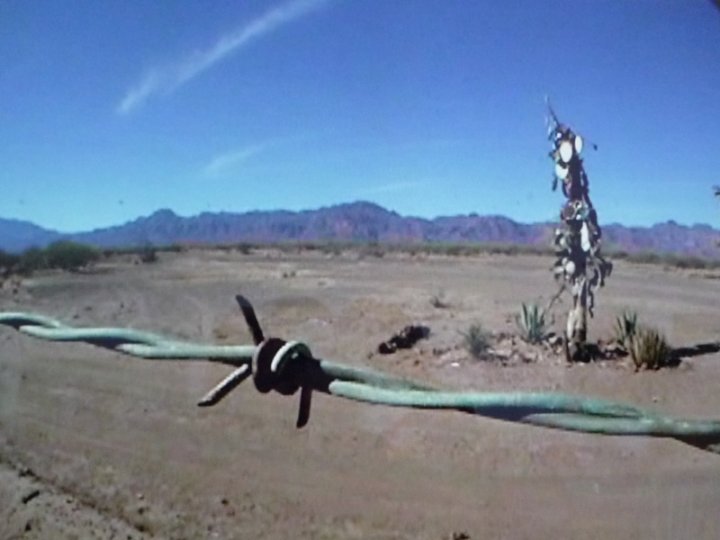
Risk
We live in a paradoxical situation: we want to avoid all risks but in reality we are confronted daily with unpredictable situations - September 11, Arab revolutions, natural disasters and so on.
Traditionally, we thought of artistic and intellectual activity as the natural place to take risk and confront authorities. This rebellious spirit seems to have dissipated over time; artists now are also seeking security and sometimes behave as simple and vulgar entrepreneurs. They have grown too sophisticated, too cynical, to believe that cultural revolution is actually possible.
For artists today, this is another challenge: How is it possible to take greater risks?
Friend
Having thousands of friends on Facebook just means having no one. The concept of friend implies a shift from ‘me’ to ‘we’, meaning emotionally connecting and thinking with others.
For this, artists today resume the third challenge: In what context can we make alliances? With whom can we share solidarity? Who will undertake adventures with us? More, how to remain independent and sovereign, while taking the risk of thinking with others to identify new frontiers?
One function of art is to allow us to explore contemporary mythologies and make us more aware of our own history and destiny in relation to the history and destiny of other human beings.
Lucas Bambozzi’s work invites us to explore this awareness with different mythologies.
Lucas Bambozzi allows us to be more human among the other humans, more alien among the other aliens, more alive among other living beings.
